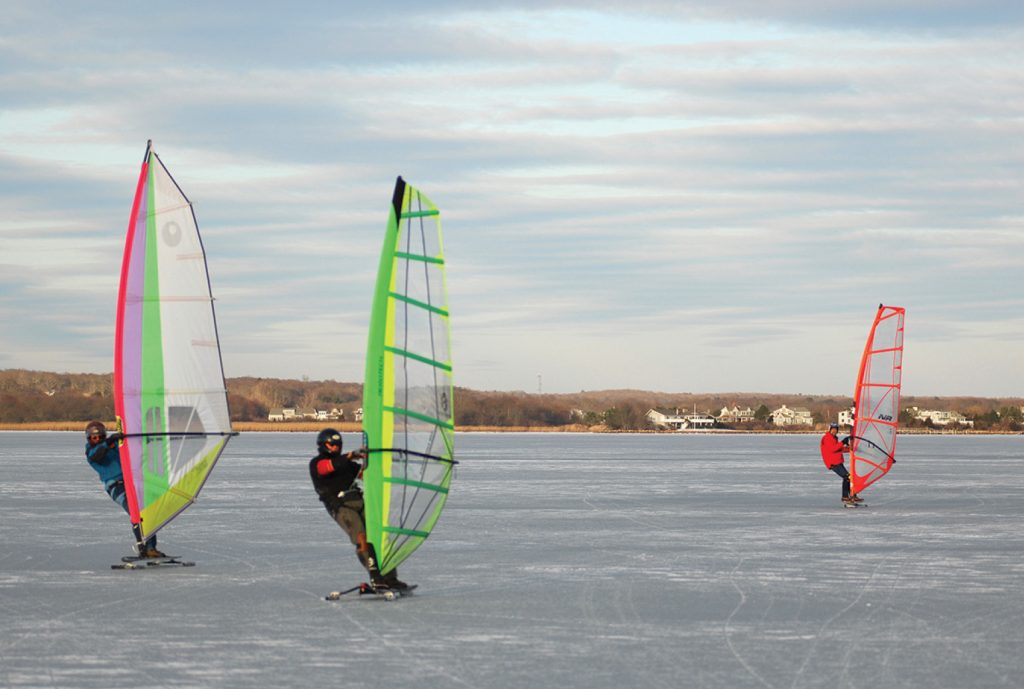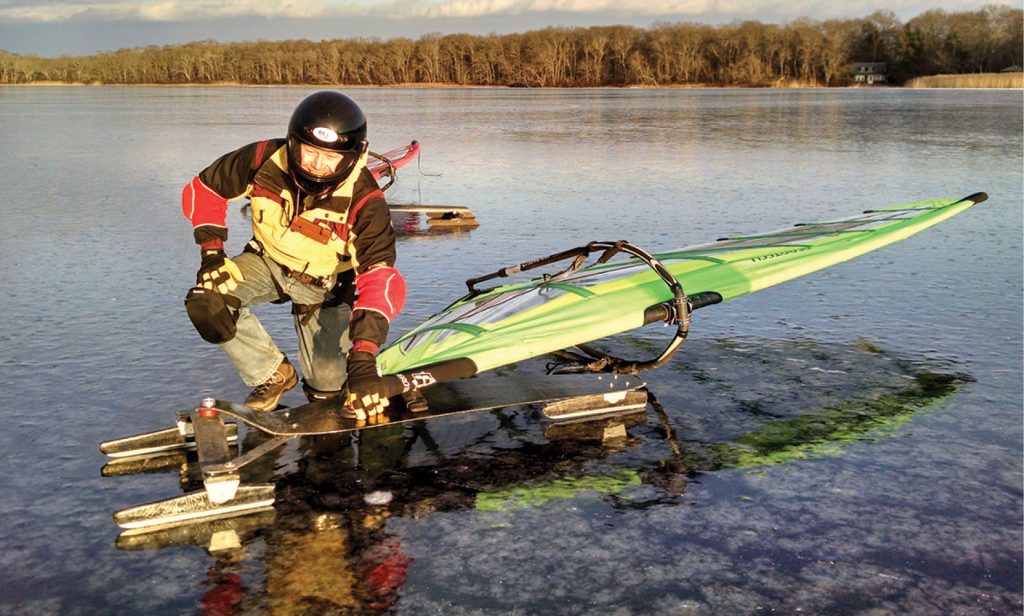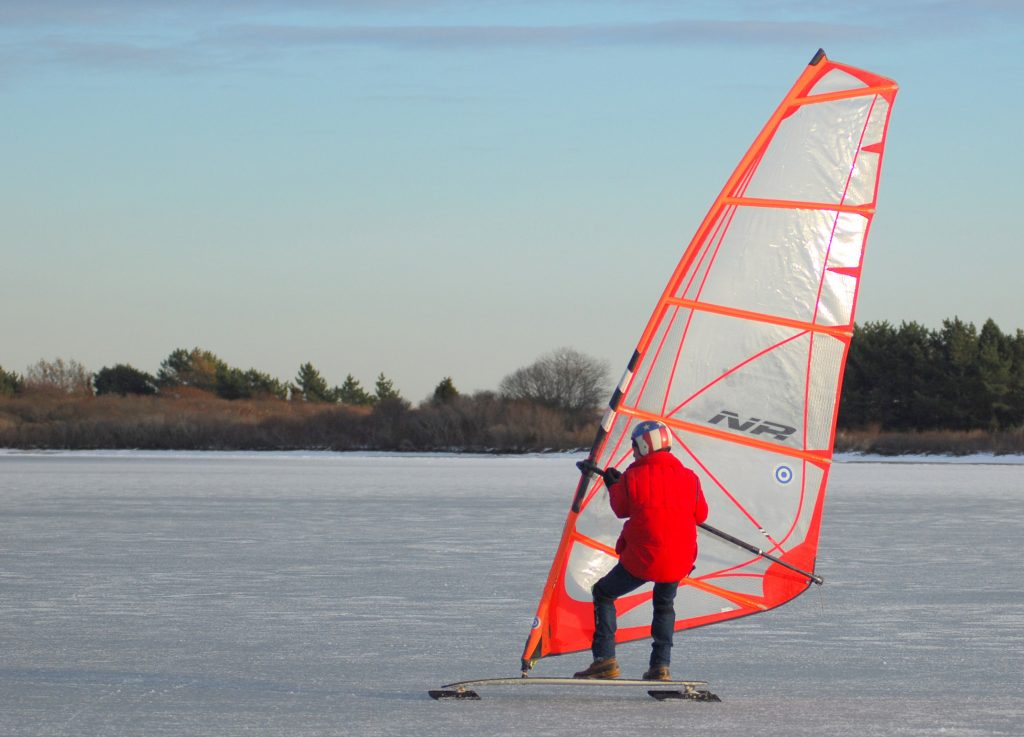By Rick Dyer
As I glide along a frozen lake carving long, graceful arcing gybes, I ask myself, “Is this an extreme sport?” “Ice Windsurfing” sounds extreme, but it feels more like figure skating! Then paradoxically realize I am wearing every bit of protective gear that I own, from helmet and kneepads to the padded seat harness affectionately known as a speed diaper. As anything, ice windsurfing can be taken to extreme, although it’s one of the most accessible winter sports there is.

Camaraderie is one of the best parts of windsurfing on ice. Pictured here are (l – r) Chris Faella, Rick Dyer and Tom Ladd. © Tom Ladd
I started ice sailing in my fifties, designed and built my own board and after twenty years of coaching ski racing in Vermont, I had found my new winter sport. I also found a level of camaraderie that equaled the early years of windsurfing. Very rare is the day on the ice that is too cold to share a beer afterwards. In fact, the constant movement on the board means it’s rare that you are ever cold on the lake. In the past there were many organized races for the popular Freeskate model of ice windsurfer; now impromptu runs with a few buddies are more the norm.
If you think sailing weather can be difficult on soft water, ice sailing takes that to another level. You need cold for several days and real cold for the ice to form up. Then it can’t snow once the ice forms, and you need wind. Luckily on ice, not a lot of wind is required. Where a windsurfer would use a 7.5 square meter sail on the water, a 4.5m sail works for most days on the ice. Another real beauty of the sport is how compact the kit is. The board resembles a bigger skateboard with steel runners replacing the wheels. With the smaller sails come shorter masts and booms. All this will actually fit inside most cars.
It may have helped that I started in southern New England, one of several hot spots for the sport worldwide, and through the Internet we stay connected with the Europeans and Mid-westerners. I spoke with Jeff Brown, the former holder of the absolute Ice Windsurfing Speed Record, about why SNE is a hot zone – if that can be said about a sport that involves ice and wind! Jeff pointed out that southern New England has freeze/thaw winters where even if we get snowed out on the ice, chances are good that thaw or rain will resurface the lakes. As a sport, ice sailing has been using online virtual competitions for several years before Covid-19 forced it upon the sailing world at large. An online contest allowed Henrik Mard of Sweden’s 67.5 mph run to just edge out Jeff’s title.

Ice windsurfing can be enjoyed on everything from a skateboard with angle iron runners to the author’s carbon fiber sled with DN60 race-inspired carbon insert blades. © Tom Ladd
The most important part of this sport is; Fun! Well, I was thinking safety, but yes fun is right up there. There are two levels of safety to deal with. The obvious one is you are standing on ice and moving at a fair turn of speed. Our Facebook page will not publish any picture in which the sailor is not wearing a helmet. Elbow and kneepads are a very good idea and of course the previous mentioned “Speed Diaper” harness. Beyond the padding of the harness, the apparent wind builds quickly and while the resistance is low it still helps to maximize it by hooking into the harness lines. I believe the number of mainsheet blocks on even a diminutive DN60 iceboat bears this out.
The other safety issue is the ice and staying dry. Having worked in the alpine world for two decades, I am still impressed with the safety preparations for ice rescue that our sailors bring to the lakes every session. Ropes are carried by most and ice axes and screws for ice checking and rescue work are in abundance. Fortunately, being prepared and vigilant means this equipment is rarely used. The saying is, “there is always thin ice somewhere” and zipping around at 40 mph is a good way to find it. Once we have ice it is usually scouted the day before on skates and the questionable areas marked out. For the first few days we sail in a fairly confined area that is known safe until the ice has fully formed up.
Once the ice is four inches thick or greater, the real fun of exploration and long speed reaches can commence. Worden Pond, a freshwater lake in southern Rhode Island, is broad and shallow which not only makes it a great sailing venue, but also one of the first to freeze up. When the word goes out that a lake is frozen, the sailors start arriving. I would like to point out that ice windsurfing is but one way to enjoy sailing on ice; there are of course iceboats, kites and kite wings on skates and skis. A good day with sun and a nice breeze soon takes on an almost carnival atmosphere. The best days are when we sail right through a beautiful sunset.

Tom Ladd enjoys a glide in this self-portrait. © Tom Ladd
As the sun sets on a handful of sailors, we have all made dozens of graceful gybes. Enjoying comradeship throughout the day just by laying the sail down, soon there will be a collection of sailors discussing the session. Then off again. I can think of no other sailing sport that allows this ease of interaction between participants. Finally, that last glide into the launch area, a quick de-rig and load up, followed up with an adult beverage and making plans to meet up for the next session and where better ice or wind might be. ■
Rick Dyer started windsurfing in 1979, and made the transition to foil sailing late summer 2020. He is kept off the water (both soft and hard) only by the building of a new winery at his WinterHawk Vineyards (winterhawkvineyards.com).
